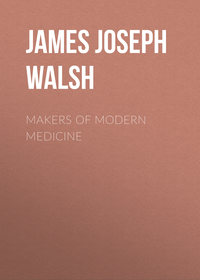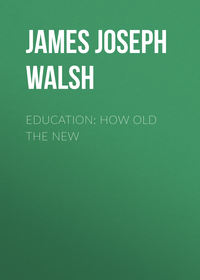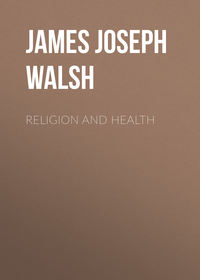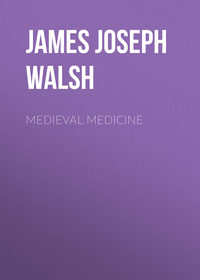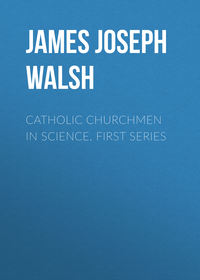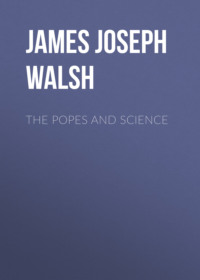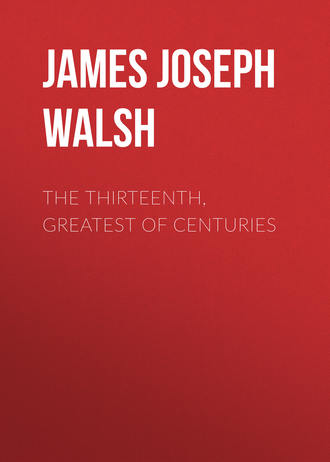 полная версия
полная версияThe Thirteenth, Greatest of Centuries
To take the example for the moment of magnetism which is usually considered to be a subject entirely of modern attention, a good idea of the intense interest of this century in things scientific, can be obtained from the following short paragraph in which Brother Potamian in his sketch of Petrus Peregrinus, condenses the references to magnetic phenomena that are found in the literature of the time. Most of the writers he mentions were not scientists in the ordinary sense of the word but were literary men, and the fact that these references occur shows very clearly that there must have been wide-spread interest in such scientific phenomena, since they had attracted the attention of literary writers, who would not have spoken of them doubtless, but that they knew that in this they would be satisfying as well as exciting public interest.
"Abbot Neckam, the Augustinian (1157-1217), distinguished between the properties of the two ends of the lodestone, and gives in his De Utensilibus, what is perhaps the earliest reference to the mariner's compass that we have. Albertus Magnus, the Dominican (1193-1280), in his treatise De Mineralibus, enumerates different kinds of natural magnets and states some of the properties commonly attributed to them; the minstrel, Guyot de Provins, in a famous satirical poem, written about 1208, refers to the directive quality of the lodestone and its use in navigation, as do also Cardinal de Vitry in his Historia Orientialis (1215-1220), Brunetto Latini, poet, orator and philosopher (the teacher of Dante), in his Tresor des Sciences, a veritable library, written in Paris in 1260; Raymond Lully, the enlightened Doctor, in his treatise, De Contemplatione, begun in 1272, and Guido Guinicelli, the poet-priest of Bologna, who died in 1276."4
The metaphysics of the medieval universities have come in for quite as much animadversion, not to say ridicule, as the dialectics. None of its departments is spared in the condemnation, though most fun is made of the gropings of the medieval mind after truth in the physical sciences. The cosmology, the science of matter as it appealed to the medieval mind, is usually considered to have been so entirely speculative as to deserve no further attention. We have presumably, learned so much by experimental demonstration and original observation in the physical sciences, that any thinking of the medieval mind along these lines may, in the opinion of those who know nothing of what they speak, be set aside as preposterous, or at best nugatory. It will surely be a source of surprise, then, to find that in the consideration of the composition of matter and of the problem of the forces connected with it, the minds of the medieval schoolmen were occupied with just the same questions that have been most interesting to the Nineteenth Century and that curiously enough the conclusions they reached, though by very different methods of investigation, were almost exactly the same as those to which modern physical scientists have attained by their refined methods of investigation.
One or two examples will suffice, I think, to show very clearly that the students of the Thirteenth Century had presented to them practically the same problems with regard to matter, its origin and composition, as occupy the students of the present generation. For instance Thomas Aquinas usually known as St. Thomas, in a series of lectures given at the University of Paris toward the end of the third quarter of the Thirteenth Century, stated as the most important conclusion with regard to matter, that "Nihil omnino in nihilum redigetur,"' "Nothing at all will ever be reduced to nothingness." By this it was very evident from the context that he meant that matter would never be annihilated and could never be destroyed. It might be changed in various ways but it could never go back into the nothingness from which it had been taken by the creative act. Annihilation was pronounced as not being a part of the scheme of things as far as the human mind could hope to fathom its meaning.
In this sentence, then, Thomas of Aquin was proclaiming the doctrine of the indestructibility of matter. It was not until well on in the nineteenth century that the chemists and physicists of modern times realized the truth of this great principle. The chemists had seen matter change its form in many ways, had seen it disappear apparently in the smoke of fire or evaporate under the influence of heat, but investigation proved that if care were taken in the collection of the gases that came off under these circumstances, of the ashes of combustion and of the residue of evaporation, all the original material that had been contained in the supposedly disappearing substance could be recovered or at least completely accounted for. The physicists on their part had realized this same truth and finally there came the definite enunciation of the absolute indestructibility of matter. St. Thomas' conclusion "Nothing at all will ever be reduced to nothingness" had anticipated this doctrine by nearly seven centuries. What happened in the Nineteenth Century was that there came an experimental demonstration of the truth of the principle. The principle itself, however, had been reached long before by the human mind by speculative processes quite as inerrable in their way as the more modern method of investigation.
When St. Thomas used the aphorism "Nothing at all will ever be reduced to nothingness" there was another signification that he attached to the words quite as clearly as that by which they expressed the indestructibility of matter. For him Nihil or nothing meant neither matter nor form, that is, neither the material substance nor the energy which is contained in it. He meant then, that no energy would ever be destroyed as well as no matter would ever be annihilated. He was teaching the conservation of energy as well as the indestructibility of matter. Here once more the experimental demonstration of the doctrine was delayed for over six centuries and a half. The truth itself, however, had been reached by this medieval master-mind and was the subject of his teaching to the university students in Paris in the Thirteenth Century. These examples should, I think, serve to illustrate that the minds of medieval students were occupied with practically the same questions as those which are now taught to the university students of our day. There are, however, some even more striking anticipations of modern teaching that will serve to demonstrate this community of educational interests in spite of seven centuries of time separation.
In recent years we have come to realize that matter is not the manifold material we were accustomed to think it when we accepted the hypothesis that there were some seventy odd different kinds of atoms, each one absolutely independent of any other and representing an ultimate term in science. The atomic theory from this standpoint has proved to be only a working hypothesis that was useful for a time, but that our physicists are now agreed must not be considered as something absolute. Radium has been observed changing into helium and the relations of atoms to one another as they are now known, make it almost certain that all of them have an underlying sub-stratum the same in all, but differentiated by the dynamic energies with which matter in its different forms is gifted. Sir Oliver Lodge has stated this theory of the constitution of matter very clearly in recent years, and in doing so has only been voicing the practically universal sentiment of those who have been following the latest developments in the physical sciences. Strange as it may appear, this was exactly the teaching of Aquinas and the schoolmen with regard to the constitution of matter. They said that the two constituting principles of matter were prime matter and form. By prime matter they meant the material sub-stratum the same in all material things. By form they meant the special dynamic energy which, entering into prime matter, causes it to act differently from other kinds and gives it all the particular qualities by which we recognize it. This theory was not original with them, having been adopted from Aristotle, but it was very clearly set forth, profoundly discussed, and amply illustrated by the schoolmen. In its development this theory was made to be of the greatest help in the explanation of many other difficulties with regard to living as well as non-living things in their hands. The theory has its difficulties, but they are less than those of any other theory of the constitution of matter, and it has been accepted by more philosophic thinkers since the Thirteenth Century than any other doctrine of similar nature. It may be said that it was reached only by deduction and not by experimental observation. Such an expression, however, instead of being really an objection is rather a demonstration of the fact that great truths may be reached by deduction yet only demonstrated by inductive methods many centuries later.
Of course it may well be said even after all these communities of interest between the medieval and the modern teaching of the general principles of science has been pointed out, that the universities of the Middle Ages did not present the subjects under discussion in a practical way, and their teaching was not likely to lead to directly beneficial results in applied science. It might well he responded to this, that it is not the function of a university to teach applications of science but only the great principles, the broad generalizations that underlie scientific thinking, leaving details to be filled in in whatever form of practical work the man may take up. Very few of those, however, who talk about the purely speculative character of medieval teaching have manifestly ever made it their business to know anything about the actual facts of old-time university teaching by definite knowledge, but have rather allowed themselves to be guided by speculation and by inadequate second-hand authorities, whose dicta they have never taken the trouble to substantiate by a glance at contemporary authorities on medieval matters.
It will be interesting to quote for the information of such men, the opinion of the greatest of medieval scientists with regard to the reason why men do not obtain real knowledge more rapidly than would seem ought to be the case, from the amount of work which they have devoted to obtaining it. Roger Bacon, summing up for Pope Clement the body of doctrine that he was teaching at the University of Oxford in the Thirteenth Century, starts out with the principle that there are four grounds of human ignorance. "These are first, trust in inadequate authority; second, the force of custom which leads men to accept too unquestioningly what has been accepted before their time; third, the placing of confidence in the opinion of the inexperienced; and fourth, the hiding of one's own ignorance with the parade of a superficial wisdom." Surely no one will ever be able to improve on these four grounds for human ignorance, and they continue to be as important in the twentieth century as they were in the Thirteenth. They could only have emanated from an eminently practical mind, accustomed to test by observation and by careful searching of authorities, every proposition that came to him. Professor Henry Morley, Professor of English Literature at University College, London, says of these grounds for ignorance of Roger Bacon, in his English Writers, Volume III, page 321: "No part of that ground has yet been cut away from beneath the feet of students, although six centuries ago the Oxford friar clearly pointed out its character. We still make sheep walks of second, third, and fourth and fiftieth-hand references to authority; still we are the slaves of habit; still we are found following too frequently the untaught crowd; still we flinch from the righteous and wholesome phrase, 'I do not know'; and acquiesce actively in the opinion of others that we know what we appear to know. Substitute honest research, original and independent thought, strict truth in the comparison of only what we really know with what is really known by others, and the strong redoubt of ignorance has fallen."
The number of things which Roger Bacon succeeded in discovering by the application of the principle of testing everything by personal observation, is almost incredible to a modern student of science and of education who has known nothing before of the progress in science made by this wonderful man. He has been sometimes declared to be the discoverer of gunpowder, but this is a mistake since it was known many years before by the Arabs and by them introduced into Europe. He did study explosives very deeply, however, and besides learning many things about them realized how much might be accomplished by their use in the after-time. He declares in his Opus Magnum: "That one may cause to burst forth from bronze, thunderbolts more formidable than those produced by nature. A small quantity of prepared matter occasions a terrible explosion accompanied by a brilliant light. One may multiply this phenomenon so far as to destroy a city or an army." Considering how little was known about gunpowder at this time, this was of itself a marvelous anticipation of what might be accomplished by it.
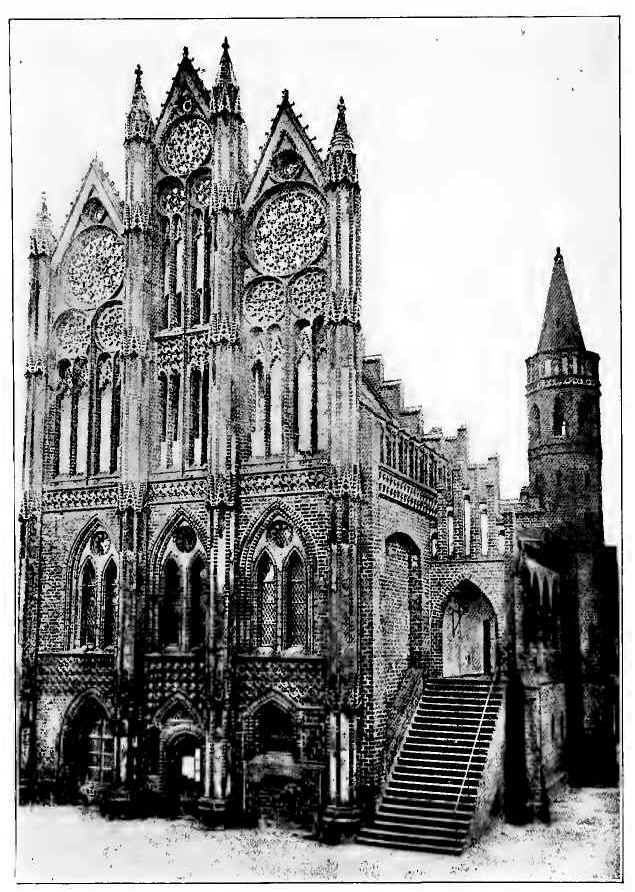
RATHHAUS (TANGERMÜNDE)
Bacon prophesied, however, much more than merely destructive effects from the use of high explosives, and indeed it is almost amusing to see how closely he anticipated some of the most modern usages of high explosives for motor purposes. He seems to have concluded that some time the apparently uncontrollable forces of explosion would come under the control of man and be harnessed by him for his own purposes. He realized that one of the great applications of such a force would be for transportation. Accordingly he said: "Art can construct instruments of navigation such that the largest vessels governed by a single man will traverse rivers and seas more rapidly than if they were filled with oarsmen. One may also make carriages which without the aid of any animal will run with remarkable swiftness."5 When we recall that the very latest thing in transportation are motor-boats and automobiles driven by gasoline, a high explosive, Roger Bacon's prophesy becomes one of these weird anticipations of human progress which seem almost more than human.
It was not with regard to explosives alone, however, that Roger Bacon was to make great advances and still more marvelous anticipations in physical science. He was not, as is sometimes claimed for him, either the inventor of the telescope or of the theory of lenses. He did more, however, than perhaps anyone else to make the principles of lenses clear and to establish them on a mathematical basis. His traditional connection with the telescope can probably be traced to the fact that he was very much interested in astronomy and the relations of the heavens to the earth. He pointed out very clearly the errors which had crept into the Julian calendar, calculated exactly how much of a correction was needed in order to restore the year to its proper place, and suggested the method by which future errors of this kind could be avoided. His ideas were too far beyond his century to be applied in a practical way, but they were not to be without their effect and it is said that they formed the basis of the subsequent correction of the calendar in the time of Pope Gregory XIII three centuries later.
It is rather surprising to find how much besides the theory of lenses Friar Bacon had succeeded in finding out in the department of optics. He taught, for instance, the principle of the aberration of light, and, still more marvelous to consider, taught that light did not travel instantaneously but had a definite rate of motion, though this was extremely rapid. It is rather difficult to understand how he reached this conclusion since light travels so fast that as far as regards any observation that can be made upon earth, the diffusion is practically instantaneous. It was not for over three centuries later that Römer, the German astronomer, demonstrated the motion of light and its rate, by his observations upon the moons of Jupiter at different phases of the earth's orbit, which showed that the light of these moons took a definite and quite appreciable time to reach the earth after their eclipse by the planet was over.
We are not surprised to find that Bacon should praise those of his contemporaries who devoted themselves to mathematics and to experimental observations in science. Of one of his correspondents who even from distant Italy sent him his observations in order that he might have the great Franciscan's precious comments on them. Bacon has given quite a panegyric. The reasons for his praise, however, are so different from those which are ordinarily proclaimed to have been the sources of laudation in distant medieval scientific circles, that we prefer to quote Bacon's own words from the Opus Tertium. Bacon is talking of Petrus Peregrinus and says: "I know of only one person who deserves praise for his work in experimental philosophy, for he does not care for the discourses of men and their wordy warfare, but quietly and diligently pursues the works of wisdom. Therefore, what others grope after blindly, as bats in the evening twilight, this man contemplates in all their brilliancy because he is a master of experiment. Hence, he knows all natural science whether pertaining to medicine and alchemy, or to matters celestial and terrestrial.
"He has worked diligently in the smelting of ores as also in the working of minerals; he is thoroughly acquainted with all sorts of arms and implements used in military service and in hunting, besides which he is skilled in agriculture and in the measurement of lands. It is impossible to write a useful or correct treatise in experimental philosophy without mentioning this man's name. Moreover, he pursues knowledge for its own sake; for if he wished to obtain royal favor, he could easily find sovereigns who would honor and enrich him."
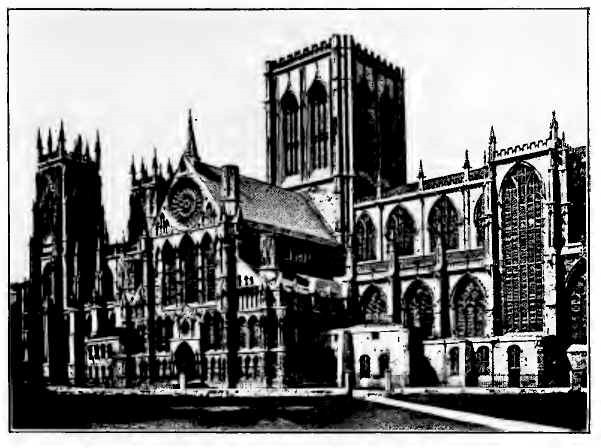
CATHEDRAL (YORK)
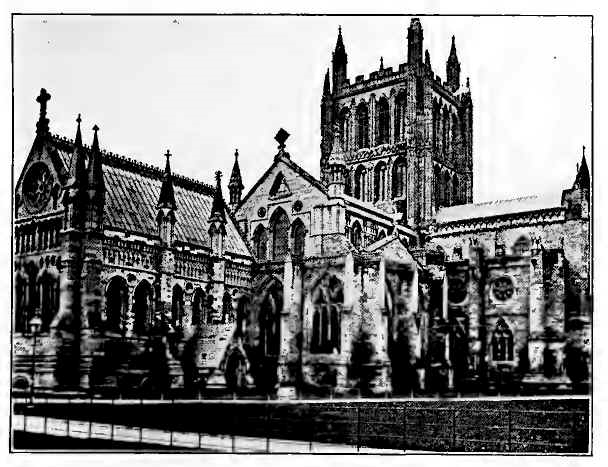
CATHEDRAL (HEREFORD)
Lest it should be thought that these expressions of laudatory appreciation of the great Thirteenth Century scientist are dictated more by the desire to magnify his work and to bring out the influence in science of the Churchmen of the period, it seems well to quote an expression of opinion from the modern historian of the inductive sciences, whose praise is scarcely if any less outspoken than that of others whom we have quoted and who might be supposed to be somewhat partial in their judgment. This opinion will fortify the doubters who must have authority and at the same time sums up very excellently the position which Roger Bacon occupies in the History of Science.
Dr. Whewell says that Roger Bacon's Opus Majus is "the encyclopedia and Novam Organon of the Thirteenth Century, a work equally wonderful with regard to its general scheme and to the special treatises with which the outlines of the plans are filled up. The professed object of the work is to urge the necessity of a reform in the mode of philosophizing, to set forth the reasons why knowledge had not made a greater progress, to draw back attention to the sources of knowledge which had been unwisely neglected, to discover other sources which were yet almost untouched, and to animate men in the undertaking by a prospect of the vast advantages which it offered. In the development of this plan all the leading portions of science are expanded in the most complete shape which they had at that time assumed; and improvements of a very wide and striking kind are proposed in some of the principal branches of study. Even if the work had no leading purposes it would have been highly valuable as a treasure of the most solid knowledge and soundest speculations of the time; even if it had contained no such details it would have been a work most remarkable for its general views and scope."
It is only what might have been expected, however, from Roger Bacon's training that he should have made great progress in the physical sciences. At the University of Paris his favorite teacher was Albertus Magnus, who was himself deeply interested in all the physical sciences, though he was more concerned with the study of chemical problems than of the practical questions which were to occupy his greatest pupil. There is no doubt at all that Albertus Magnus accomplished a great amount of experimental work in chemistry and had made a large series of actual observations. He was a theologian as well as a philosopher and a scientist. Some idea of the immense industry of the man can be obtained from the fact that his complete works as published consist of some twenty large folio volumes, each one of which contains on the average at least 500,000 words.
Among these works are many treatises relating to chemistry. The titles of some of them will serve to show how explicit was Albert in his consideration of various chemical subjects. He has treatises concerning Metals and Minerals; concerning Alchemy; A Treatise on the Secret of Chemistry; A Concordance, that is a Collection of observations from many sources with regard to the Philosopher's Stone; A Brief Compend on the Origin of the Metals; A Treatise on Compounds; most of these are to be found in his works under the general heading "Theatrum Chemicum."
It is not surprising for those who know of Albert's work, to find that his pupil Roger Bacon defined the limits of chemistry very accurately and showed that he understood exactly what the subject and methods of investigation must be, in order that advance should be made in it. Of chemistry he speaks in his "Opus Tertium" in the following words: "There is a science which treats of the generation of things from their elements and of all inanimate things, as of the elements and liquids, simple and compound, common stones, gems and marble, gold and other metals, sulphur, salts, pigments, lapis lazuli, minium and other colors, oils, bitumen, and infinite more of which we find nothing in the books of Aristotle; nor are the natural philosophers nor any of the Latins acquainted with these things."
In physics Albertus Magnus was, if possible, more advanced and progressive even than in chemistry. His knowledge in the physical sciences was not merely speculative, but partook to a great degree of the nature of what we now call applied science. Humboldt, the distinguished German natural philosopher of the beginning of the Nineteenth Century, who was undoubtedly the most important leader in scientific thought in his time and whose own work was great enough to have an enduring influence in spite of the immense progress of the Nineteenth Century, has summed up Albert's work and given the headings under which his scientific research must be considered. He says:
"Albertus Magnus was equally active and influential in promoting the study of natural science and of the Aristotelian philosophy. His works contain some exceedingly acute remarks on the organic structure and physiology of plants. One of his works bearing the title of 'Liber Cosmographicus de Natura Locorum,' is a species of physical geography. I have found in it considerations on the dependence of temperature concurrently on latitude and elevation, and on the effect of different angles of incidence of the sun's rays in heating the ground, which have excited my surprise."
To take up some of Humboldt's headings in their order and illustrate them by quotations from Albert himself and from condensed accounts as they appear in his biographer Sighart and in Christian Schools and Scholars6, will serve to show at once the extent of Albert's knowledge and the presumptuous ignorance of those who make little of the science of the medieval period. When we have catalogued, for instance, the many facts with regard to astronomy and the physics of light that are supposed to have come to human ken much later, yet may be seen to have been clearly within the range of Albert's knowledge, and evidently formed the subject of his teaching at various times at both Paris and Cologne, for they are found in his authentic works, we can scarcely help but be amused at the pretentious misconception that has relegated their author to a place in education so trivial as is that which is represented in many minds by the term scholastic.





